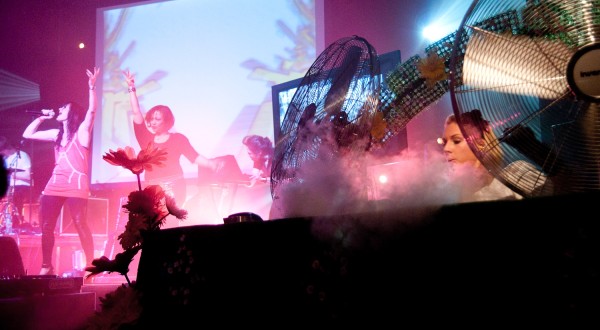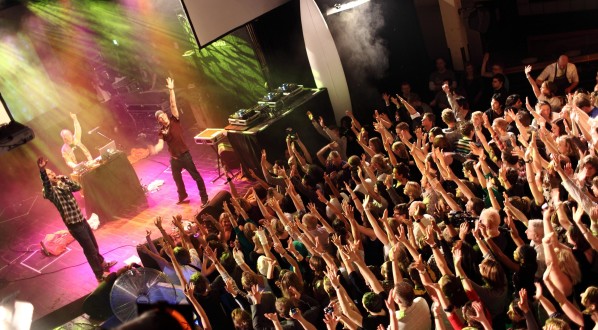
Clouds of fragrant smoke wafted from the stage, crafted by the “aroma jockeys” with bubbling vessels of frozen nitrogen and futuristic fans, blasting the audience with heady mixtures of bergamot, lavender and sandalwood.
Hula hoops twirled round waists. Light shows twinkled. And the dance floor vibrated – literally –from an array of mechanised transducers synchronized with the (very) loud bass.
You’d easily mistake Sencity, held last month in London, for simply an opulent club night – until you saw the hands waving in the air. Everywhere the crowd bristled with conversations, fingers dancing as their owners looked expressively at each other, speaking with their eyes. Animated conversations were undisturbed by the music booming from the speakers.
Sencity, born in the Netherlands in 2003 – and which has since held nights in Brazil, Sydney, Spain, Jamaica, Finland, South Africa and Mexico – is a night tailored for the needs of the Deaf: around 35 per cent of the crowd is profoundly deaf, and another third are hearing impaired to some degree.
With music nights geared for those who cannot hear, Sencity claims to “make the impossible possible” – and challenges what the rest of us might think about the Deaf community. Most Deaf people can still perceive some level of sound, and all still have the capacity to appreciate music. But even those who live in a fully silent world can still experience the tactile qualities of sound (especially when the bass is cranked up).
But Sencity is not, its organizers stress, to be confused with a ‘Deaf rave,’ which is designed solely for the Deaf community. Those, say Sencity’s London promoter Timothy Bonham-Carter, simply reinforce divisions that exist between the Deaf and the hearing worlds.
“The idea is to bring the hearing and Deaf communities together but not in a way that is deemed exclusive,” says Bonham-Carter.
With the tagline ‘see, hear, feel, taste, smell the music’, the result is an event that caters to everyone’s senses – and which can hopefully break down perceived barriers not just between the Deaf and the hearing but also within the Deaf community itself.
“Sencity is about making the impossible possible: people often live in a protected environment and therefore do not look at what they can achieve with their talents,” says Bonham-Carter.
Take the night’s top-billed performer, Finnish rapper Signmark, the first Deaf person in the world to be signed to a major international record label. According to his website: “With his music Signmark wants to change attitudes towards the Deaf… he feels that the society should not treat the Deaf as handicapped, but as a linguistic minority with their own culture, community, history and heritage.”

This desire to be recognized as a linguistic minority runs throughout the Deaf community: one of the aims of the British Deaf Association is to achieve legal status for British Sign Language as an indigenous minority language in the UK. This, they state, would “lead to an equality of opportunity for our Deaf community through the protection and promotion of our language”.
This need for protection is essential, say campaigners, due to the rise of cochlear implants, which have been promoted for thirty years as a ticket to the world of sound.
“The debate for cochlear implants rages on,” explains Bonham-Carter. “The Deaf community at large resents them due to the way they are eroding their cultural identity. The main problem is that if two hearing parents have a Deaf child, they are swiftly advised by the medical fraternity to give the child a cochlear implant without being informed that their child will be alienated from the sign language majority of their community.”
Moreover, implants are not a ‘cure’ for deafness, and do not restore normal hearing to the recipients. Their hearing will be dim and imprecise. Children given implants will still require intensive speech therapy in order to develop the language skills necessary to converse with hearing people – but this secondary support is frequently absent or inadequate. Implanted children may find themselves disadvantaged twice over, lacking the capacity to converse with either the hearing or the Deaf.
“It is all well and good one being able to hear, but it’s no good if they cannot respond as a person who has full use of their residual hearing and vocals,” says Bonham-Carter.
Threats to their language and their culture are very real to the Deaf community, especially with technological improvements to the batteries of the implants and the potential for couples undergoing IVF treatment to select against having Deaf children. This issue is extremely controversial: clauses in the Human Fertilization and Embryology Bill that were perceived to be discriminatory were labelled as “eugenic” in the United Kingdom three years ago.
The future for Deaf language is uncertain, at least in developing countries where the capacity to create hearing children is economically feasible. Cochlear implant devices cost roughly £16,500 ($26,000), but this balloons to £60,000 ($96,000) over thirty years when rehabilitation and maintenance are factored in, according to Deafness Research UK. One cycle of IVF costs around £5,000, ($8,000) although many cycles may be necessary.
For the organizers of Sencity, the solution is not to create a gathering solely for the Deaf, but to create something that would bring the rest of us into contact with deaf people in a way we seldom (if ever) are.